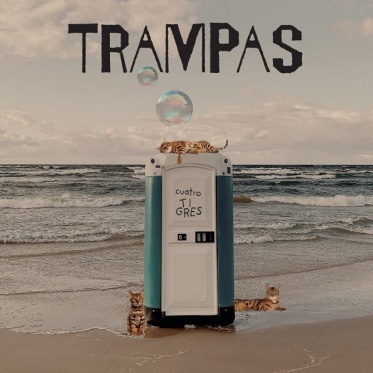The small Biscayan town of Getxo has been an enclave subject to a constant artistic turmoil in recent decades. Context in which the origin of the band is inscribed traps, which, far from being a new outbreak of this continuous creative microclimate, is the result of the alliance between various musicians, led by Álvaro Real de Asúa, defined by an outstanding previous career. A lustrous resume, as endorsed by the names of El Inquilino Comunista, Zodiacs, Gringo or Arana, which although it can serve as consistent credentials, these are firmly backed by three albums that have their continuation in the current “Four Tigers”. An album that continues to reach out to indie-rock and other genres of a distorted nature, which could perfectly signify the structural DNA of the group, but which maintains, and exponentiates, that progression in search of increasing its catalog of sounds with the ultimate goal of aspire to shape a concept, from all its edges, more substantial.
Given the English-speaking militancy of the group, the use of a title in Spanish, with a clairvoyant language, is nothing more than the mechanism with which to underline the very configuration of the band. But when it comes to acrobatic curiosities, having assumed this work -mixed by his inseparable ally, Jonan Ordorika, – the swan song for the recording studio where it was recorded, Grabasonic, seems to play the role of an omen regarding songs that in their content, also in their frizzy condition at times, they revolt against a social decadence where uncertainty and existential discouragement are accommodated with increasing naturalness.
If this album stands out, among other things, for displaying a whole glossary of diverse musical accents, at the same time it manages to transfer that versatility to its texts, which can be born from the dictation of acid ironic games, expressed under overwhelming meanings or wrapped between cryptic or metaphysical. But if there is any environmental element that the entire album has in common, it is a reiterated -sometimes expressed copiously and other times as a veil dropped surreptitiously- atmospheric tone, metaphorically anticipated on the cover by those soap bubbles that accompany the tigers and that ends up becoming an identifying sign of the personality of the work.
Although it is not the most orthodox when it comes to breaking down the bulk of an album to start with its last song, “Can’t Live Like This” resides in an illustrative compendium of both those known ingredients in the band and those used in a new way in This time. Because this theme of course works as an ode to distortion, but at the same time it is accompanied by keyboards, which extend its depth, and a subtle nostalgic tone drawn with traces of classic rock, a nuance that is especially visible in the country side. , well driven by the participation of a female voice, from “Green Diet”, with which they line up along with the representatives of that trend called Paisley Underground. Subtleties that despite what it might seem, will not be overshadowed, they will simply alter their codes, due to the furious call of some guitars that bear the designation of origin of bands like Dinosaur Jr. or Hüsker Dü, reproducing direct and accurate hits in “ Searching the Word”, appealing to the noise of “Run Run”, invoking its own title through a discharge of energies of variable intensity in “Hear the Thunder” or the delirious reverie of “They Play on”, a “prayer” Dedicated to all its references of the six strings.
But Trampas lives not only by taking the volume of the amplifiers to the maximum; that would be too easy, and without this meaning relieving the strings of his instruments, he coexists in “Bubble Boy”, and his claustrophobic pandemic portrait, a more elegant handling, in which one could speak of Big Star or Teenage Fanclub, along with a dreamlike contribution coming largely from the presence of the keyboards, equally essential in “Followers”, a judicious sentence against the tawdry segregated by social networks, in the achievement of a garage tone embodied between a hammering cadence of riffs, the same ones that despite developing twisted dialogues of crude vocabulary in “Wanna Be an Indian” they are the background landscape for a melodic interpretation. Differences or alterations in the voltage that will disappear completely for just a moment, space to give way to the night owl and intimist “C’mon”.
With this album, the Biscayan band expands the area of action from which their sound acts -characterized by that primal indie-rock with a corrosive spirit but harmonic implantation- until they achieve a perimeter of sharper ends and widen the breadth of their registers. . New pieces for a puzzle that obviously offers a photograph of the band under a greater color range but still clearly recognizable. Four tigers that in this way prove to be able to both show their sharper nails than ever and approach docilely to be caressed, without ever forgetting that their feline condition implicitly roars as a form of communication.
